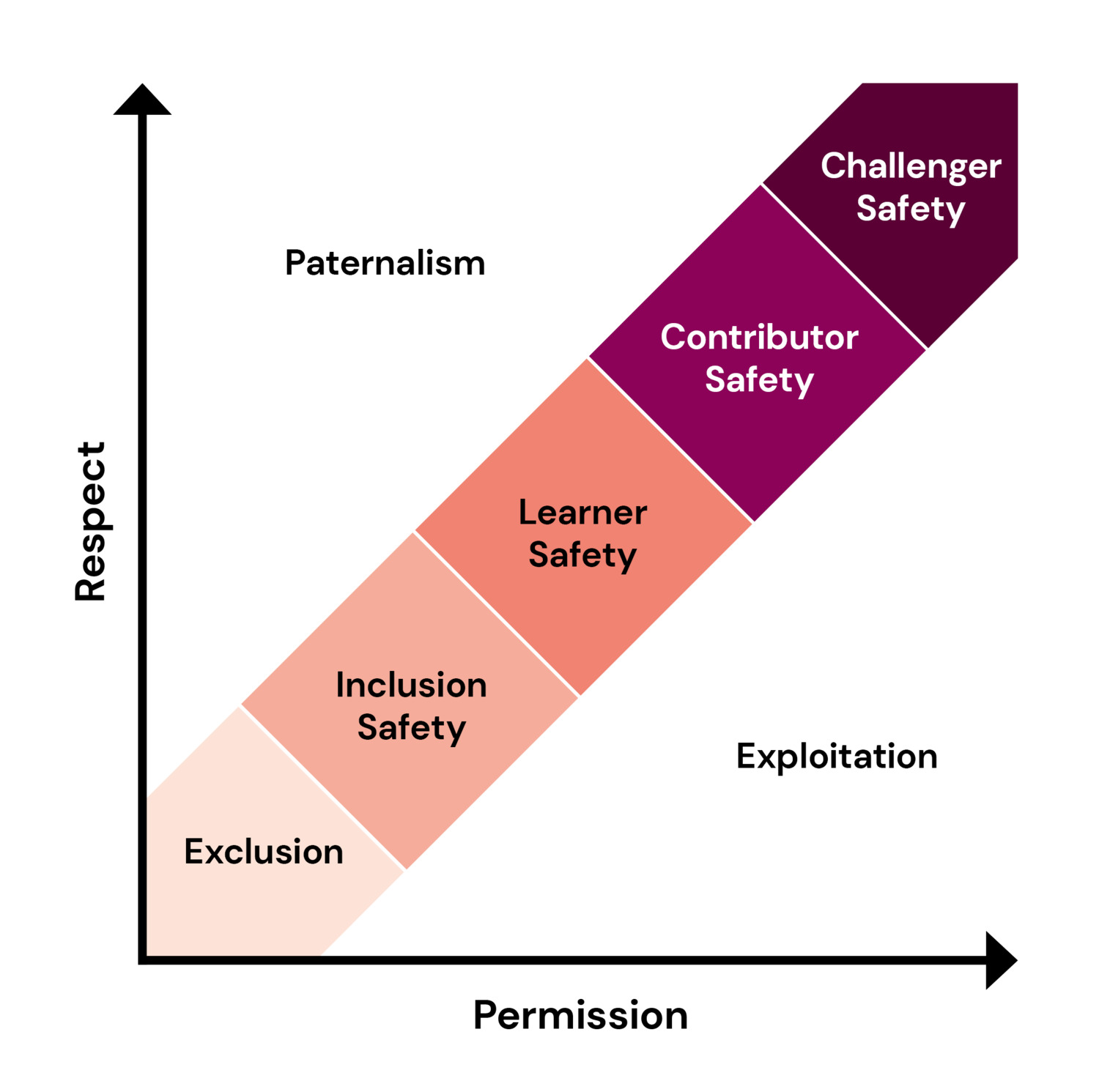Fostering Psychological Safety in the Educational Setting
Teaching and supervising at Karolinska Institutet is not only about imparting knowledge and comptence but also about creating a safe and inclusive space for both educators and students. By navigating through the stages of psychological safety, you contribute to an environment that nurtures learning, growth, and innovation.

Psychological safety, explored by researchers like Amy Edmondson and Timothy R. Clark, plays a crucial role in the healthcare sector. Edmondson's research has focused on team dynamics and organizational behavior, while Clark describes it as a continuous level of safety in the workplace or learning environment, where respect and permission are paramount.
Respect involves how individuals treat each other with dignity and consideration, while permission pertains to the freedom to interact, participate, and collaborate (Clark, 2020).
Clark's four levels provide teachers and mentors with the opportunity to monitor the development of psychological safety and tailor their teaching strategies to address specific challenges at different stages of the progression.
Psychological safety is a condition in which you feel (1) included, (2) safe to learn, (3) safe to contribute, and (4) safe to challenge the status quo - all without fear of being embarrassed, marginalized, or punished in some way.
Exclusion: Navigating the Initial Connections
Exclusion is the starting point where individuals come together without prior connections or work history. At this stage, there is a lack of familiarity, and by default, individuals find themselves in a state of exclusion. They may feel like outsiders, leading to a sense of uncertainty and hesitancy in interaction. As individuals move beyond this stage, they start to interact, and patterns of behavior, termed as "norms," begin to emerge.
As an educator and supervisor, recognize that at the beginning of any course, students may feel a sense of exclusion due to unfamiliarity. Foster an inclusive atmosphere by facilitating introductions, encouraging collaboration, and setting the stage for the formation of positive norms.
Establishing Norms: Actively work towards creating inclusive norms as students begin to interact. Set the tone for a collaborative and supportive learning community.
Inclusion Safety (Stage 1)
Inclusion safety marks the transition from exclusion to a state where individuals feel included, accepted, valued, and appreciated. This stage addresses the fundamental human need for connection and belonging. It's characterized by a sense of unity and acceptance within the group. Research indicates that 92% of employees worldwide prioritize this stage as their first basic human need—being included, accepted, and valued (Clark, 2020).
Move beyond exclusion to create an environment where students feel included, accepted, and valued. Acknowledge and address the human need for connection and belonging by promoting a culture of acceptance.
Learner Safety (Stage 2): Encouraging Acts of Vulnerability
Learner safety signifies a stage where individuals not only feel included but also have the confidence to engage in acts of vulnerability associated with learning. This involves asking questions, giving and receiving feedback, admitting ignorance, experimenting, and making mistakes without the fear of punitive consequences.
Promote learner safety by encouraging students to engage in acts of vulnerability associated with learning. Create a space where asking questions, giving and receiving feedback, and embracing mistakes are viewed as essential components of the learning process.
- Rewarding Vulnerability: Actively reward acts of learning vulnerability to instill confidence in students to explore and inquire without fear.
Examples in how to foster/model vulnerability in educational setting
Modeling vulnerability as an educator or supevisor is a delicate but valuable endeavor that can enhance the learning experience for students. Here are some strategies to effectively model vulnerability:
- Express Genuine Enthusiasm for Learning:
- Show enthusiasm for learning new things, and openly express curiosity about topics outside your immediate expertise.
- This reinforces the idea that everyone, including the instructor, is on a continuous learning journey.
- Share Decision-Making Processes:
- When appropriate, explain the thought process behind certain teaching decisions or course design choices.
- This transparency helps students understand the rationale behind your actions and fosters a sense of shared decision-making.
- Admit Mistakes and Learn from Them:
- Acknowledge and take responsibility for any mistakes you make, whether they are related to course content, assignments, or communication.
- Demonstrate a commitment to continuous improvement and learning.
- Encourage Student Feedback:
- Explicitly invite feedback from students about your teaching methods, materials, and overall course structure.
- Use constructive feedback as an opportunity to demonstrate openness to improvement.
- Admit Areas of Limited Expertise:
- It's okay to acknowledge when there are areas in which you are not an expert. Encourage students to explore these topics independently and share their findings with the class.
- Express Vulnerability with Purpose:
- Share vulnerability with a clear purpose tied to a learning objective or the overall goals of the course.
- Avoid oversharing personal details that are unrelated to the educational context.
- Demonstrate a Growth Mindset:
- Embrace a growth mindset by showcasing your willingness to take on challenges, learn from setbacks, and persist in the face of difficulties.
- Create a Supportive Classroom Culture:
- Foster a classroom culture that values open communication, empathy, and mutual respect.
- Encourage students to share their thoughts, questions, and experiences in a supportive environment.
Contributor Safety (Stage 3):
Building on the foundation of inclusion and learning, contributor safety focuses on providing students with the opportunity to make meaningful contributions. At this stage, the deep human need for purpose and meaning in one's work comes to the forefront. Students seek assurance that their contributions matter and make a positive impact.
- Purpose and Meaning: Guide your teaching approach where students are given opportunities to make meaningful contributions. Provide autonomy, clarify roles, and offer guidance to meet the deep human need for purpose and meaning in their academic journey.
Challenger Safety (Stage 4):
Challenger safety is the culminating stage where students feel secure enough to challenge the status quo without fear of negative consequences. This stage is critical for innovation, as it involves pushing boundaries, questioning existing norms, and exploring new solutions. Incorporate challenger safety into your teaching philosophy, enabling students to challenge without fear of negative consequences.
- Readiness for Innovation: Understand that crossing into stage 4 signifies a readiness for innovation, fostering an environment where students can contribute to solving complex problems. Embrace intellectual friction, encouraging students to question norms and explore innovative solutions.
Challenges in Achieving Psychological Safety
Cultural Tone Deafness and Compliance
Leaders/teachers/supervisors mistakenly assume they can decree a "speak up" culture without creating the necessary conditions for psychological safety. Remember that it is a continuum and students readiness to challenge and even contribute depends on if the lower stages are fulfilled.
"Red Flags"
- In environments lacking psychological safety, patterns of silence or superficial niceness emerge as coping mechanisms.
 Photo: Pixabay
Photo: PixabayShare your experiences and tips
We would like to share examples from different KI contexts of how you apply these concepts. We intend to use your examples to highlight good practice, build a knowledge base and promote collaborative learning.
Contribute with your example!
References and related reading/listening
- Clark, T. R. (2020). The 4 stages of psychological safety: Defining the path to inclusion and innovation (First edition). Berrett-Koehler Publishers, Inc.
- Edmondson, A. C. (2019). The fearless organization: Creating psychological safety in the workplace for learning, innovation, and growth. Wiley.
- Edmondson, A. C., Higgins, M., Singer, S., & Weiner, J. (2016). Understanding Psychological Safety in Health Care and Education Organizations: A Comparative Perspective. Research in Human Development, 13(1), 65–83. https://doi.org/10.1080/15427609.2016.1141280
